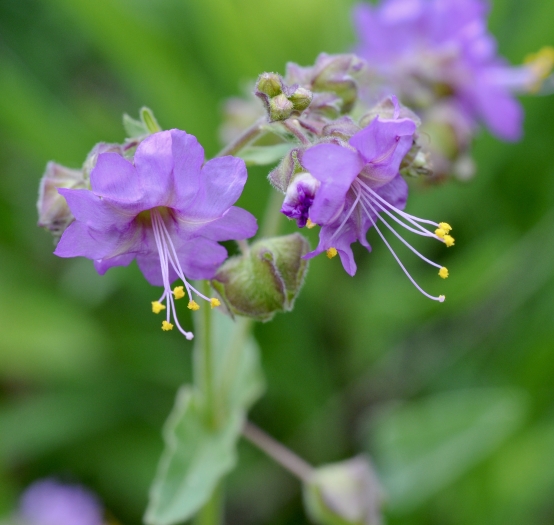Heartleaf Four O’Clock
(Mirabilis nyctaginea)
Heartleaf Four O’Clock (Mirabilis nyctaginea)
/
/

sonnia hill
CC BY 2.0
Image By:
sonnia hill
Recorded By:
Copyright:
CC BY 2.0
Copyright Notice:
Photo by: sonnia hill | License Type: CC BY 2.0 | License URL: https://creativecommons.org/licenses/by-sa/2.0/ | Uploader: sonnia hill | Publisher: Flickr |



































































Estimated Native Range
Summary
Mirabilis nyctaginea, commonly known as Heartleaf Four O’Clock, is a deciduous perennial herb native to open prairies and grasslands in the Western and Central USA, as well as parts of Canada and Mexico. It can grow erect to over a meter in height and is characterized by its heart-shaped leaves and hairy to hairless stems. The flowers, which are most notable for their evening opening, occur in clusters of 3 to 5 within a bell-shaped involucre of five partly fused bracts. Each flower is a five-lobed, funnel-shaped bloom about a centimeter wide, ranging in color from magenta or pink to nearly white. The flowers are ephemeral, opening for only a few hours in the late afternoon to evening and dropping soon after, leaving behind the shaggy-haired developing fruits enclosed in the drying, papery cup of bracts. The plant has a thick, fleshy taproot.
Heartleaf Four O’Clock is appreciated for its unique flowering habit, opening in the evening and attracting pollinators such as moths. It is used in native plant gardens, borders, and as a naturalizing species in appropriate regions. It thrives in full sun and is adaptable to various soil types, provided they have good drainage. While it requires medium amounts of water, it can tolerate some drought once established. Gardeners should be aware that Mirabilis nyctaginea can self-seed and spread, potentially becoming invasive in some areas. It is advisable to check local regulations and guidelines before planting to prevent unwanted spread.CC BY-SA 4.0
Heartleaf Four O’Clock is appreciated for its unique flowering habit, opening in the evening and attracting pollinators such as moths. It is used in native plant gardens, borders, and as a naturalizing species in appropriate regions. It thrives in full sun and is adaptable to various soil types, provided they have good drainage. While it requires medium amounts of water, it can tolerate some drought once established. Gardeners should be aware that Mirabilis nyctaginea can self-seed and spread, potentially becoming invasive in some areas. It is advisable to check local regulations and guidelines before planting to prevent unwanted spread.CC BY-SA 4.0
Plant Description
- Plant Type: Herb
- Height: 2-3 feet
- Width: 2-3 feet
- Growth Rate: Moderate
- Flower Color: Pink, Yellow, Purple, White
- Flowering Season: Summer
- Leaf Retention: Deciduous
Growth Requirements
- Sun: Full Sun
- Water: Medium
- Drainage: Slow, Medium, Fast
Common Uses
Bee Garden, Bird Garden, Butterfly Garden, Fragrant, Hummingbird Garden, Low Maintenance, Rabbit Resistant, Rock Garden, Showy Flowers
Natural Habitat
Native to open prairies and grasslands in the Western and Central USA, parts of Canada, and Mexico
Other Names
Common Names: Wild Four O’Clock, Heartleaf Umbrella Wort
Scientific Names: , Mirabilis nyctaginea, Oxybaphus nyctagineus, Oxybaphus cervantesii, Allionia nyctaginea, Mirabilis cervantesii, Mirabilis nyctagineus, Allionia cervantesii, Calymenia cervantesii, Oxybaphus cucullatus
GBIF Accepted Name: Mirabilis nyctaginea (Michx.) Mac Mill.